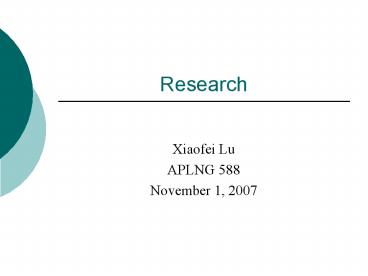Research - PowerPoint PPT Presentation
1 / 22
Title:
Research
Description:
Changes brought about by technology on tasks, environments and outcomes ... Winkler (2001): think-aloud protocol, interview. Taylor and Gitsaki (2003): WELL course ... – PowerPoint PPT presentation
Number of Views:38
Avg rating:3.0/5.0
Title: Research
1
Research
- Xiaofei Lu
- APLNG 588
- November 1, 2007
2
Overview
- Final project format
- Defining CALL research
- Criteria for effective CALL research
- Call research approaches
3
Defining CALL research
- Variables in the CALL process
- Learners, language, context
- Tools, tasks/activities, peers and teachers
- CALL research
- Variables and system containing these variables
- Interactions between the variables
- Effects of the variables on each other
3
4
Why CALL research
- To understand
- Changes brought about by technology on tasks,
environments and outcomes - New opportunities provided by technology
- Relationship to CALL theory and practice
- A strong, common foundation lacking
- Practice and theory should inform each other
- Research helps us describe more generalizable
information - Who are CALL researchers?
4
5
What should we ask
- How new tools and contexts affect students
attitudes - Are students learning? At what rate? How much? Of
what? Based on what? Caused by what? - What students learning looks like
- Roles of peers and teachers in this learning
- Differences made by different tools in this
learning - What else students learn while learning language
- How students develop culturally, personally, and
socially during and as a result of LL with
technology
6
How to conduct CALL research
- Explaining language gains
- Difficult to measure
- Strong foundation in SLA research theory helps
- Methods
- Use of true experimental designs problematic
- Qualitative and quantitative methods
- Research questions determine methods
- Rigor is important
7
Perspective in CALL
- A perspective in research may relate to
- A topic (culture, flow, visuality, etc.)
- A theory (sociocultural, constructivist, etc.)
- A research approach (design based, etc.)
- Study questions and methods vary depending on
perspective (Fig 1.2, p. 8) - Multiple perspectives necessary
8
Criteria for effective CALL research
- Weaknesses in previous CALL research
- Guidelines for improvement
9
Weaknesses in previous research
- Lack of theoretical and/or data support
- Handle Corl (1998)
- Lynch, Fawcett Nicolson (2000)
- Blake (2000) and Li (2000)
- Biased positive assumption about CALL
- Beauvois (1997) LAN-based interaction
- Lewin (2000) basic e-books
- Mltiwalla Tello (2000) online instruction
- Cifuentes Shin (2001) NS/NNS email exchanges
- Sengupta (2001) benefits and limitations of CALL
10
Technocentrism in CALL research
- Media comparison design
- Ignoring human and other factors
- Biesenbach-Lucas Weasenforth (2001) e-mail vs.
word processor - Instructional comparison design
- Comparing CALL and traditional instruction
- Al-Seghayer (2001) video vs. print for voca
acquisition - Tool analysis
11
Avoiding Technocentrism
- What really matters for language instruction?
- Technology?
- Teacher, learning environment, students?
- Good examples
- Underwood (2000) computer-supported reading
- Meskill et al. (1999) electronic texts
- Surry Ensminger (2001)
- Instructional method and learner characteristics
- Designs and methods
12
Guidelines for improvement
- Link SLA theory to questions and analysis
- Adopt a well-suited research design
- Avoid technocentric views and assumptions
- Provide strong evidence to support claims
- Discuss negative results and limitations
13
CALL research approaches
- Introduction
- Overview of research approaches
- Discussion
14
Introduction
- Focus on language teaching and learning
- Learner attitudes and perceptions
- Theory-driven studies
- LL tasks involved in enabling LL
- Informs and refine pedagogical approaches
- Focus on material design
- Development process
- Testing design elements
- Effective ways to improve design
15
Overview of research approaches
- Survey research
- Assessing student attitudes and perceptions
towards - A collection of activities, e.g., web-enhanced LL
- A particular CALL product or artifact (Table 6.1,
p146) - A network of methods
- Hoshi (2003) interaction and content analysis
- Winkler (2001) think-aloud protocol, interview
- Taylor and Gitsaki (2003) WELL course
- Longitudinal research design
- LL broadly conceived (language, technology, etc.)
16
Comparative studies
- Proof of effectiveness of new technology in LL
- Experimental vs. control group
- Criticisms
- CALL not a single, discrete method of
instruction
17
Researching LL through chat
- Use of synchronous CMC for LL
- Tudini (2003)
- NNS-NS interactions in distance learning
- LL operationalized in terms of IA
- Opportunities for negotiation of meaning
- Chat work integrated into course for assessment
- Identified negotiation sequences from chat corpus
18
Researching intercultural LL through email
- ODowd (2003)
- Qualitative, longitudinal study over a year
- Ethnographic
- Byrams (1997) model of intercultural
communicative competence - Identified characteristics of email exchange
leading to IL
19
Researching L2 reading on the web
- Chun (2001)
- How 23 2nd-year German learners accessed
information using a web-based program - Multimedia components of special interest
- Tracking program
20
Researching student use of feedback and help
- Tracking learner behavior
- Tracking student response to feedback
- Pujola (2001, 2002)
- Identifies LL strategies used in accessing help
facilities in a web-based multimedia program - Identifies and groups patterns of behavior
21
Experimental research
- Choosing most effective annotation design
- Jones (2003)
- Best multimedia annotations supporting listening
comprehension and voca acquisition - A control group and 3 treatment groups
- Inferential statistics and interviews
- Students recall more propositions with visual and
verbal annotations than with one annotation - Best condition for acquiring vocabulary
22
Discussion
- Characteristics of good CALL research
- Theory, research and pedagogy
- A broader view of LL
- Seeking the optimal design
- Suggestions for planning future studies































